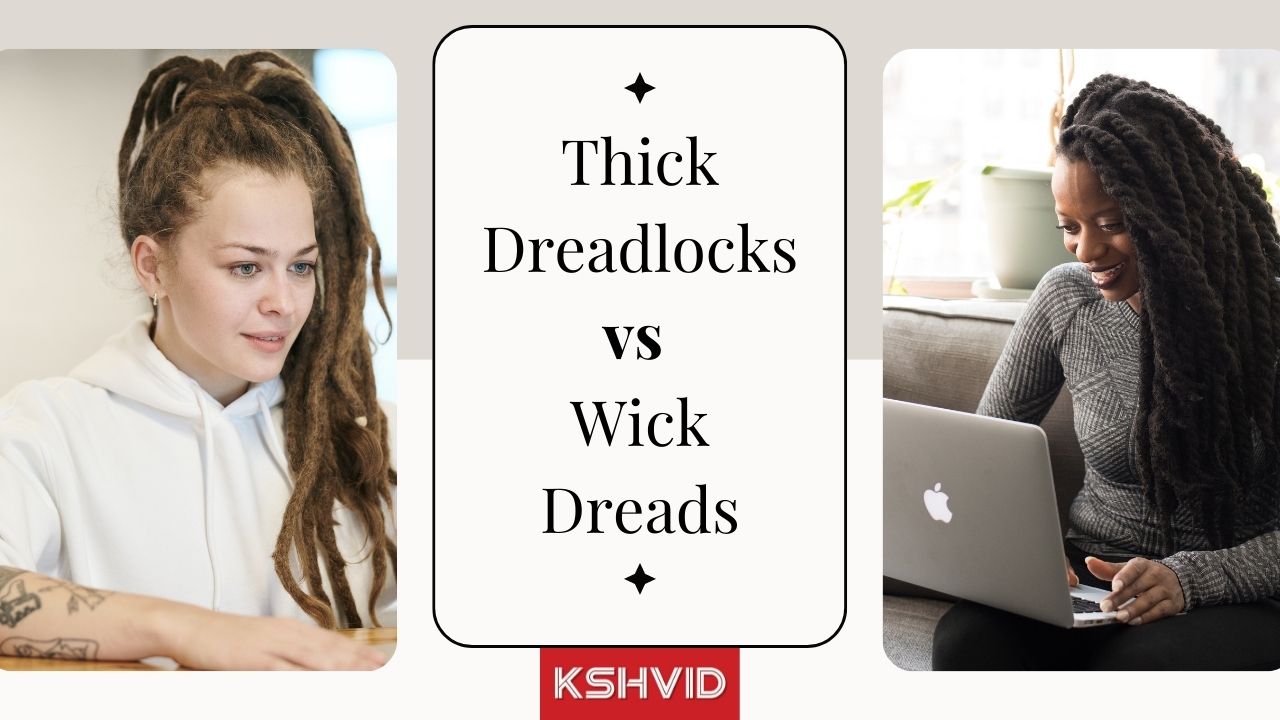Wick dreads are an ancient locs style that is also considered thick dreadlocks. The major difference lies in the thickness of the locs and the technique used for locs installation.
Picking the right hairstyle according to your personality and comfort is one of the challenges that no one discusses. It depends on your style, personality and several other factors, such as hair type, hair texture, hair length and volume.
Dreadlocks are the hottest hairstyle that is gaining popularity among the masses. If you have decided to style your hair with dreadlocks, you need to pick the right style.
There are different locs, such as thin locs, including traditional locs, microlocs, and sisterlocs. Likewise, thick dreadlocks include wicks.
This article will guide you about which type of dread is right for you. In addition, we will describe thick Dreadlocks vs Wick Dreads. So, continue reading to learn more about them.
Read: What is Soft Locs? 3 Steps To Take Down Soft Locs
What are Thick Dreadlocks?
Thick locs contain more diameter and are made by taking a wide section of hair. Thick locs are created with the three methods, including crochet and freeform.
According to the locs size chart, the locs with diameters ranging from 12mm to 15mm and above are considered thick locs.
Thick locs can be started from natural hair by different methods such as the freeform method, crochet method, palm rolling or others.
Thick locs differentiate from other types of locs by their appearance and thickness. In addition, the thick locs are quite high-maintenance locs as they are not easy to handle while washing, cleaning and drying.
Furthermore, the locs are not handled easily to manage into different hairstyles due to their thickness.
What are Wicks Dreadlocks?
As the name reveals, the wick locs are named after the wick of a candle that stands straight rather than falling.
Wick locs can be achieved only if you already have locs on your head. Many celebrities are now influenced by this dreadlock hairstyle look and are rocking wicks.
Wick locs are easily curated with the freeform locs, but if you have other traditional locs, you will need some time to curate the new hair growth.
Wicks are thick dreadlocks that cover the head with a few wicks, such as only 4-10 wicks. Thin dreadlocks make 100-500 dreads on the head, depending on the hair texture and volume.
If you have thin locs or any other type of locs, you can easily curate them into wicks. In addition, thick dreadlocks extensions available in the market can be purchased and used to make wicks easily.
Read: What’s the difference between Microlocs vs Sisterlocks
Thick Dreadlocks vs Wick Dreads Major Differences
Although wicks are another type of thick dreadlocks, they are quite different. So, let’s dig into the major differences between thick dreadlocks and wicks.
1: Thickness
The major difference between thick dreadlocks and wicks is their diameter.
The normal thick locs range from 12mm to 15 mm, whereas the diameter of the wick ranges from 2 inches to 6 inches. Depending on the hair texture and volume, it can be varied.
2: Number
The second most important difference is the number of dreads on the head. Thick locs can range from 40 to 200 locs with an average diameter.
The number can vary depending on your comfort and style. Wicks makes 4-10 dreads on the full head.
3: Appearance
There is no confusion regarding thick dreadlocks vs. wicks, as they both appear different. By having a single glance, you can easily decide which dreads are thick and which are wicks. Wick dreads appear less in number and as thick, strong and straight as the candle wicks. On the other hand, the thick dreads are more in number with thick twisted rope-like strands.
4: Maintenance
Thick dreadlocks can be maintained by adding to your haircare regime, such as extra nourishment, head covering and washing on time.
Both dreadlock types need retwisting sessions to be in good shape and condition. One must be mindful of covering their locs before sleeping at night.
But, with wicks, it becomes tough to manage hair in different seasons without getting build-up and catching a skin infection.
In addition, it is quite a challenge to wash and dry wicks. Furthermore, the wicks being thick in diameter, are prone to product and sweat buildup in hot and humid weather.
5: Styling
Styling makes a huge difference when it comes to making a decision. For example, if you love to style hair every morning, you must go with thick locs or medium-thick dreadlocks.
Although there are very few thick dreadlocks styles, you can easily convert thick, short dreadlocks into wicks if you fail to manage them. Wicks transform your look for a long time as you already make a statement hairstyle that needs no further styling.
Read: 5 Steps for Bleaching Honey Blonde Locs – Follow Tips
Final Words:
Wicks and thick locs both make beautiful hairstyles. However, both are different and identical in some ways. Thick dreadlocks vs wick dreads are a great way to get creative styles with your natural hair.
To sum up, both types of dreads are unique and attractive. Both need extra time and attention for maintenance and can be created from scratch. So, one must know the pros and cons of both dreadlocks types before starting one.
FAQs
What makes locs thicker?
The key to making the locs thicker is to hydrate them daily. In addition, keeping them tightened by retwisting or palm-rolling also adds to their texture.
Do dreadlocks get thicker over time?
Yes, to some extent. No matter what type of dreadlocks you start your locs journey, the locs mature and become thick with the passing years.
What are thick dreadlocks called?
Thick dreadlocks are named wicks as they have a huge diameter that no other type of locs has. Apart from wicks, the locs with a diameter of more than 12mm are also called thick dreadlocks.
Read:
10 Light Skin with Dreads Hairstyle Ideas







